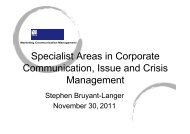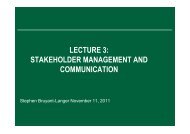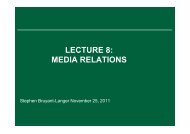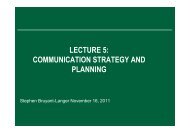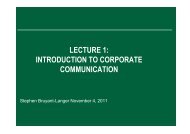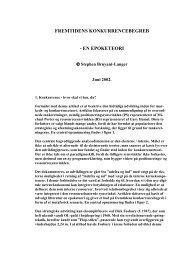LECTURE 10 ISSUE AND CRISIS MANAGEMENT
Lecture 10 November 30, 2011
Lecture 10 November 30, 2011
- No tags were found...
Create successful ePaper yourself
Turn your PDF publications into a flip-book with our unique Google optimized e-Paper software.
<strong>LECTURE</strong> <strong>10</strong>:<br />
<strong>ISSUE</strong> <strong>AND</strong> <strong>CRISIS</strong> <strong>MANAGEMENT</strong><br />
Stephen Bruyant-Langer November 30, 2011
Lecture Structure<br />
• Background to issues and crisis management<br />
• Defining issues and crises<br />
• Managing issues<br />
• Crisis management
Background to Issues and Crisis Management<br />
• Issue and crises emerge in interactions between organizations and stakeholders in<br />
society<br />
• Managing issues is given in by the importance of maintaining, nurturing and protecting<br />
reputations and stakeholder relationships<br />
• Issues and crisis management is generally part of the more strategic dimension of the<br />
corporate communication function’s role (Grunig and Repper, 1992)
Contemporary Issues<br />
• Diet/obesity – food producers (Coca Cola, Nestle, McDonald’s)<br />
• Fat cat pay/corporate governance – multinationals, large firms (Glaxo, Shell)<br />
• 9/11 and safety – airlines (Swiss Air, Sabena)<br />
• Buying/supply chain (sweat shop) – manufacturers (Nike, Starbucks)
Defining Issues and Crises<br />
• An issue can be defined as (a) a concern about the organization’s<br />
decision and operations; that may or may not also involve (b) a point of<br />
conflict in opinions and judgments regarding a company’s decisions and<br />
operations.<br />
(a) For example, when Mattel recalled millions of toys in 2007<br />
because of dangerously high levels of chemicals and toxins, the<br />
recall became an issue of public concern about the safety of the<br />
company’s supply chain and manufacturing in China. Mattell,<br />
however, acknowledged the problems and hence there was no<br />
difference of opinion with customers and members of the general<br />
public about the severity of the issue and about the necessity of a<br />
product recall.<br />
(b) In contrast, the petroleum company Exxon Mobil has been at<br />
loggerheads with scientists and environmental groups about the<br />
issue of global warming and its own role in reducing its carbon<br />
emissions.
• Chase (1984) - an issue as ‘an unsettled matter which is ready for a<br />
decision whereas a trend is a detectable change which precedes an<br />
issue’.<br />
• Hainsworth (1990) – ‘an issue is a point of conflict between an<br />
organisation and one or more of its publics’.<br />
• The term ‘issues management’ was first coined by Howard Chase in<br />
the 1970s.<br />
• Issues management is the capacity to understand, mobilize, co-ordinate,<br />
and direct all strategic and policy planning functions, and all corporate<br />
communication/public relations skills towards the achievement of one<br />
objective: meaningful participation in creation of public policy that affects<br />
institutional destiny.<br />
• Maturing in his thinking, Chase (1984) defined issues management as a<br />
process of issue identification, analysis, change strategy options, action<br />
programming, and evaluation of results.
• A crisis is defined as an issue that requires not just decisive but also<br />
immediate action from the organization. The necessity of immediate<br />
action may be triggered by, for example, mounting public pressures,<br />
intense media attention or because of the direct danger (in case of an<br />
accident, product tampering or faulty products) to employees, customers<br />
or members of the general public.<br />
• Weick (1988) - a crisis is an critical and intense issue that threatens the<br />
very existence of an organization in terms of its basic assumptions,<br />
values and ways of operating. For example, when Shell attempted to<br />
dispose of the Brent Spar oil rig in the North Sea, its actions led to a<br />
public boycott and to legislation that not only damaged its reputation but<br />
also challenged the company to change its basic assumptions and<br />
values regarding the environmental impact of its business.
Development of an Issue into a<br />
Crisis
Managing Issues<br />
• Issues management is first of all a corporate intelligence function, but<br />
to realize its potential it must be treated as part of the strategic<br />
management function - bringing issues into the heart of the strategic<br />
decision-making process and corporate communication.<br />
• Four steps:<br />
(1) environmental scanning<br />
(2) issue identification and analysis<br />
(3) issue-specific response strategies<br />
(4) evaluation.
(1) Environmental scanning – SWOT, DESTEP, stakeholder<br />
engagement<br />
(2) Issue identification and analysis<br />
• present intensity of the issue in the public domain; how likely it<br />
is to trigger government action or impact on public opinion; the<br />
likelihood of the issue continuing; the ability of the organization to<br />
influence its resolution; and the key stakeholder groups and<br />
publics that are involved with the issue<br />
• Stakeholders: position-importance matrix to position stakeholder<br />
opinions on the issue<br />
• Present intensity/stage of the issue: Healey’s ‘lifecycle’ model
Position–importance Matrix<br />
-5<br />
Oppose<br />
Position on<br />
Problematic<br />
Antagonistic<br />
Issue<br />
0<br />
Support<br />
Low Priority<br />
Supporter<br />
+5<br />
0 5 <strong>10</strong><br />
Least<br />
Most<br />
Importance
Healey’s life cycle model
(3) Issue-specific response strategies<br />
• a buffering strategy<br />
• a bridging strategy<br />
• an advocacy strategy.<br />
The choice of any one of these three options is based upon the<br />
‘intensity’ of the issue, the importance of the issue to the<br />
organization’s stakeholder groups, values and beliefs of<br />
managers in an organization and costs.
• A buffering strategy is essentially an attempt to ‘stonewall the issue’ and delay<br />
its development. This strategy is one in which organizations attempt to continue<br />
with their existing behaviour by postponing decisions or by remaining silent.<br />
Buffering involves trying to keep claims from stakeholders or publics in the<br />
environment from interfering with internal operations.<br />
• A bridging strategy, on the other hand, involves organizations being open to<br />
change and recognizing the issue and its inevitability. Bridging occurs when<br />
organizations seek to adapt organizational activities so that they conform with<br />
external expectations and claims of important stakeholders and publics.<br />
• An advocacy strategy is an attempt to try to change stakeholder expectations<br />
and public opinions on an issue through issue campaigns and lobbying. Within<br />
this strategy, organizations do not directly ‘stonewall’ an issue (buffering) or<br />
adapt to external expectations (bridging) but use campaign and lobbying to alter<br />
the opinions and stakeholder expectations on an issue so that these conform to<br />
the organization’s present practices, output and values
(4) Evaluation. The final stage of the issues management process<br />
involves an evaluation of how the issue has developed and how<br />
stakeholder expectations and public opinions have changed.
Crisis Management<br />
• An issue may evolve into a crisis when organizations do not deal with<br />
issues in a timely or responsible manner or when stakeholders or the<br />
general public feel that an organization has not adequately responded<br />
to an issue.<br />
• However, not all crises are self-inflicted by organizations or emerge<br />
from widely debated public issues.
Crisis Types<br />
Unintentional<br />
Intentional<br />
External Faux pas Terrorism<br />
Internal Accidents Transgressions
• A faux pas is an unintentional action that an external agent (e.g.,<br />
NGO) unintentionally transforms into a crisis. A faux pas often<br />
begins as an issue between an organization and a particular<br />
external agent who challenges the appropriateness of the<br />
organization’s actions.<br />
• When an organization does not engage in debate with this<br />
external agent or when public opinion and stakeholder<br />
expectations move against the organization, the issue may turn<br />
into a crisis. Social responsibility tends to be the focal point of<br />
most faux pas. The term faux pas comes from French and literally<br />
means ‘false step’. It generally refers to a violation of accepted,<br />
although unwritten, social rules and expectations.
• Accidents are unintentional and happen during the course of normal<br />
organizational operations. Product defects, employee injuries and<br />
natural disasters are all examples of accidents. The unintentional and<br />
generally random nature of accidents often leads to attributions of<br />
minimal organizational responsibility, unless of course the organization<br />
was directly responsible for the accident.<br />
• Accidents can be further divided into acts of nature (e.g., hurricanes,<br />
earthquakes, epidemics, etc.) and human-induced errors (e.g., industrial<br />
accidents). The rationale for this division is that stakeholders and publics<br />
are less likely to attribute blame and react negatively to acts of nature<br />
than to human-induced error
• Transgressions are intentional acts taken by an organization that<br />
knowingly place stakeholders or publics at risk or harm. Knowingly<br />
selling defective or dangerous products, witholding safety information<br />
from authorities, violating laws, or ‘creative’ bookkeeping are all<br />
examples of transgressions.<br />
• Terrorism refers to intentional acts taken by external agents. These<br />
intentional actions are designed to harm the organization directly (e.g.,<br />
hurt customers through product tampering) or indirectly (e.g., reduce<br />
sales or disrupt production). Product tampering, hostage taking,<br />
sabotage and workplace violence are all examples of terrorism
Crisis communication<br />
• Classifying crises into these four types is useful because it<br />
provides a basis for identifying the most appropriate crisis<br />
communication strategy.<br />
• The principle for choosing an appopriate communication strategy<br />
is the degree to which the organization is perceived by<br />
stakeholders and the general public to be reponsible or culpable<br />
for the crisis.<br />
• When the perception is that the organization is not directly<br />
responsible or culpable the organization may attempt to<br />
distance itself from the crisis or deny that the crisis exists or is<br />
as serious as external actors make it out to be. On the other<br />
hand, when the organization is seen as directly responsible or<br />
culpable for the crisis, the organization will have to defend its<br />
position or may simply have to apologise for the crisis and<br />
change its behavior.
Perception of low level of responsibility<br />
Nonexistence strategies Claim of denying the crisis<br />
1. denial A simple statement denying that a crisis exists<br />
2. clarification An extension of the denial tactic with attempts to explain why there<br />
is no crisis<br />
3. attack and intimidation A tactic of confronting the person or group who claims that a crisis<br />
exists; may include a threat to use “force” (e.g., a lawsuit) against<br />
the accuser<br />
Distance strategies Claim of distancing the organization from direct responsibility<br />
for the crisis<br />
1. excuse A tactic of denying intention or volition by scapegoating others for<br />
the crisis<br />
2. downplay A tactic of convincing stakeholders or the general public that the<br />
situation is not that bad in itself or compared to other crises<br />
Association strategies Claim of connecting the organization to things positively valued<br />
by stakeholders and publics<br />
1. bolstering A tactic of reminding stakeholders and the general public of<br />
existing positive aspects of the organization (e.g., reminders of past<br />
charitable donations or a history of fair worker treatment) in order<br />
to offset the negatives the crisis brings to the organization<br />
2. transcendence A tactic of associating the negatives and loss arising from a crisis<br />
with a desirable, higher order goal (e.g., animal testing to develop<br />
life-saving drugs)<br />
Suffering strategy Claim that the organization suffers from the crisis<br />
1. victimisation A tactic of portraying the organization as a victim of the crisis in<br />
order to win public sympathy<br />
Perception of high level of responsibility<br />
Acceptance strategy Claim accepting responsibility or culpability for the crisis<br />
1. full apology A tactic of simply apologising for the crisis and accepting the blame<br />
2. remediation A tactic of announcing some form of compensation or help to<br />
victims (money, goods, aid, etc.)<br />
3. repentance A tactic of asking for forgiveness. The organization apologises for<br />
the crisis and asks stakeholders and the general public to forgive its<br />
misdeeds<br />
Accomodative strategy Claim promising to prevent the crisis from recurring again<br />
1. rectification A tactic of taking corrective action to prevent a recurrence of the<br />
crisis in the future
• The unintentional nature and external challenge of a faux pas may lead<br />
to an attribution of minimal organizational responsibility. However, an<br />
organization can often change in response to the challenge which<br />
means that the possibility of a perception of organizational responsibility<br />
for the crisis does exist. When the perception of organizational<br />
responsibility is low or weak, the organization may use a distance<br />
strategy to further weaken the linkage between the crisis and the<br />
organization. However, when the perception of organizational<br />
responsibility for a faux pas is high or strong, an organization will have to<br />
follow an acceptance or accomodative strategy. Besides apologizing for<br />
the crisis and openly accepting the blame, this may consist of<br />
remediation (giving compensation to victims) or rectification (taking<br />
corrective action to prevent the crisis from happening again).
• Natural accidents are unintentional and outside of the control of<br />
organizations. Such accidents can therefore be easily responded to with<br />
a distancing strategy which serves to reinforce the organization’s lack of<br />
responsibility for the crisis.<br />
• Human-error related accidents are more difficult to justify and will require<br />
an apology from the organization and an admission that it will take<br />
action to prevent a recurrence of the crisis in the future.<br />
• Transgressions are intentional actions taken by organizations which<br />
makes organizations directly responsible for their impact. A strategy of<br />
distancing the organization from the crisis or a non-existence strategy<br />
that denies the existence of the crisis are thus futile. Organizations<br />
instead need to follow an acceptance
strategy where they admit their responsibility but work to atone for the<br />
crisis in some fashion. For example, an organization may remediate by<br />
willingly offering some form of compensation or help to victims, may<br />
repent by publicly asking for forgiveness, or may follow a rectification<br />
tactic of ensuring that the crisis will not recur in the future.<br />
Terrorist attacks are directed at the organization by external agents and<br />
often there is very little direct organizational responsibility or culpability.<br />
An organization may therefore adopt a suffering strategy which portrays<br />
the organization as an unfair victim of some malicious, outside actor.<br />
Johnson & Johnson’s famous portrayal of itself as wounded by product<br />
tampering during the 1982 Tylenol crisis is a good example of the<br />
suffering strategy.




